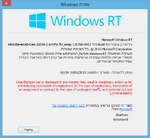Windows 8 build 8509
| Build of Windows 8 | |
 | |
| OS family | Windows NT |
|---|---|
| Version number | 6.2 |
| Build number | 8509 |
| Build revision | 0 |
| Architecture | x86, ARM32 |
| Build lab | fbl_eeap |
| Compiled on | 2012-07-08 |
| Expiration date | |
| Timebomb | 2013-01-15 (+191 days) |
| SKUs | |
| RT (CoreARM) Pro | |
| About dialog | |
Windows 8 build 8509 is a pre-RTM build of Windows 8, which was released to Microsoft partners participating in the Ecosystem Engineering Access Program (EEAP). It was first shown running on a Lenovo ThinkPad Tablet 2 reviewed by tech review website Booredatwork.[1] The ARM32 compile of this build in Hebrew language was later uploaded to the Internet Archive on 20 February 2023.[2]
This build includes Microsoft Office 2013 build 4128.1015 (HomeStudentPre edition) preinstalled, with setup files residing in the \MSOCache directory. It is the last available build of Windows 8 to feature the Windows wordmark on the boot screen, as the next set of builds would change it to instead use the final RTM design, which simply features the 2012 Windows logo.
Similarly to the unidentified December 2011 build, build 8375, and build 8504, despite not being publicly released by Microsoft, the standard set of built-in Metro applications is included by default.
Changes[edit | edit source]
User interface[edit | edit source]
Accent color[edit | edit source]
The default accent color has been changed to a distinct purple. This change was also similarly observed exclusively in the WinPE setup packages for earlier builds, such as build 8441.
Inbox applications[edit | edit source]
The standard set of inbox Metro applications, as well as the Microsoft Office 2013 productivity suite, is now bundled into the OS image by default exclusively for ARMv7 releases. This change, however, would not be reflected for any other system platform until Windows 8.1 build 9347 (sans the Office suite).
Sleep lock timeout[edit | edit source]
The toggle to switch between a requiring a password when waking a device from sleep has been replaced with a sleep lock timeout, in an effort to reduce the chances of malicious actors from quickly gaining access to user data from stolen PCs. The option is variable, and the timeout can be modified to automatically lock the user's device for every 1 to 15 minutes of inactivity.
The timeout can be changed from the Immersive Control Panel user interface.
Gallery[edit | edit source]
ARM32 compile[edit | edit source]
Interface[edit | edit source]
Desktop with
winver
[edit | edit source]
References[edit | edit source]
- ↑ Etteh, Enobong. Lenovo ThinkPad Tablet 2 Hands-on, Booredatwork. 8 August 2012.
- ↑ https://archive.org/details/8509.fbl_eeap.armfre.he-il





